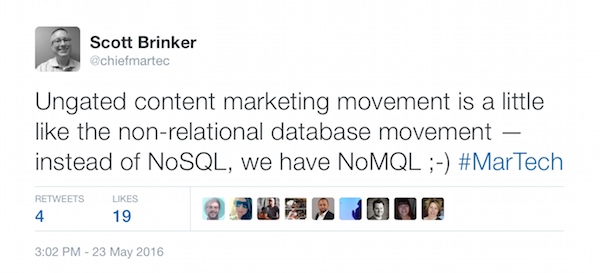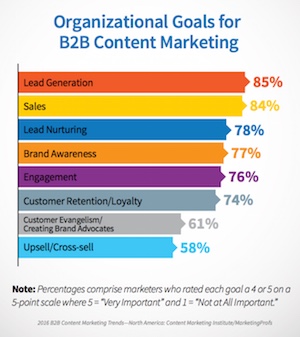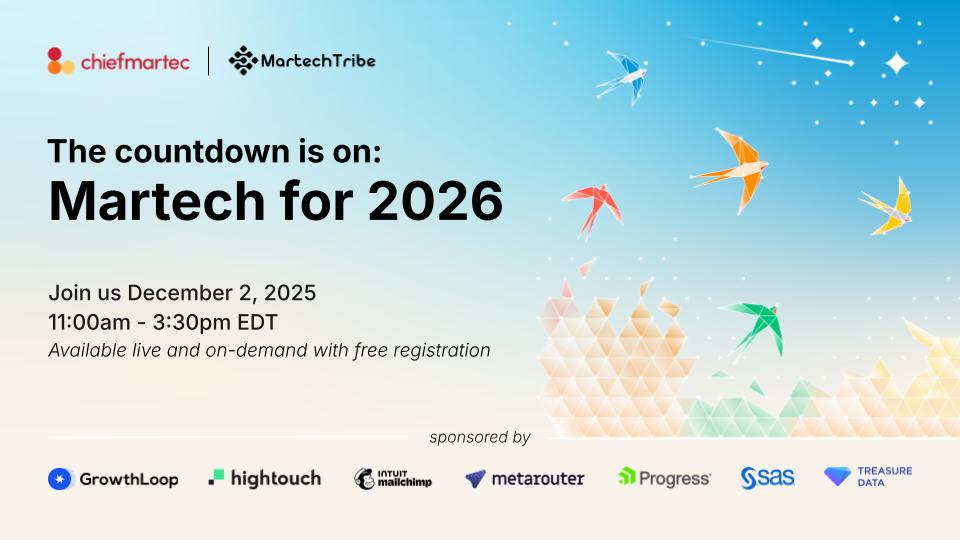Let me start by saying that if you get the joke in the above tweet — even if you don’t find it a particularly good joke — you have marketing technologist street cred.
This story starts with a post I read by Dave Gerhardt, the head of marketing at Drift, which I had seen circulating on Twitter, stirring the content marketing pot: Why We’re Throwing Out All Of Our Lead Forms And Making Content Free.
It’s like a John Lennon song, “Imagine there’s no lead form — I wonder if you can.”
As Dave points out, gating “premium” content — white papers, reports, ebooks, webinars, etc. — with lead generation forms has been a staple of certainly B2B digital marketing over the past decade. For many companies, this is a primary feeder of marketing qualified leads (MQLs).
According to the Content Marketing Institute and MarketingProf’s annual survey, lead generation is the #1 organizational goal for B2B content marketing.
So when David Cancel, Drift’s CEO, proposed eliminating all forms in front of the marketing team’s content, you can probably imagine Dave’s puzzlement. Say what?
But as Dave thought through it — a process he candidly describes in his post — it started to make more sense. He recognized that many of the brands and products he loves, like Slack and MailChimp, don’t gate their content. People adopt and then advocate for those products because they genuinely love them, not because they’ve been “nurtured” to do so through a back-and-forth volley of lead forms and email follow-ups.
So they decided to do it: they nixed all gating forms to all marketing content.
Now, a few caveats to note, as I can hear spluttering objections through the screen:
- They still invite people to optionally subscribe to their newsletter.
- They still have people sign up to try their product (“freemium trials”).
- Freemium trials are not the same as leads, but they’re not entirely dissimilar either.
- Freemium trials obviously only work for businesses than can offer such things.
- The results of this grand experiment over time remain to be seen.
So the circumstances for Drift make this more feasible for them than it might be for other kinds of companies. In the fine print: your mileage may vary.
But as radical of a move as this may seem through the eyes of a marketer, if we put on a prospect’s hat — remember, we’re all committed to being customer-centric, right? — this actually seems, well, pretty nice.
No more lead forms to fill out? No more spam nuture emails or phone calls from marketing or sales people, aggressively pushing me towards the next step in their funnel? I get the content I want, when I want it, without jumping through hoops, and then I decide if and when I want to pursue a closer relationship.
That would be pleasant, wouldn’t it?
I’ve made more than a few jokes at the expense of adland executives who delusionally insist, “Consumers actually like advertising!” It just needs to be creative, targeted, relevant, yadda yadda. And then it’s A Really Good Thing. Really!
Um, no.
At best, consumers tolerate ads. And the evidence suggests that they avoid them whenever they can. Banner blindness. Ad blockers. Shifting away from ad-saturated TV.
But while it’s fun to laugh at Mr. Delusional Adperson, if we’re being completely honest with ourselves, we have to acknowledge echoes of that logic in many of our “demand generation” programs. Who exactly is doing the demanding with these lead forms and email follow-ups?
Prospects may tolerate that. But it’s dubious that they like it.
In that light, Drift’s Free Your Marketing movement may be genuis. If marketing were to just focus on two things — (1) giving prospects great content and helpful utilities (interactive content), with no strings attached, and (2) making sure that our company’s products and services are truly delightful — so that customers exercise free will to buy them, renew them, and recommend them — could that grow business more effectively?
Would our brand be the better for it?
Do we have enough faith in our content and products to believe that prospects will choose us under their own impetus? (For that matter, despite all our demand generation machinery, has it ever really been otherwise?)
Marketing Wars, Episode V: Brand Marketing Strikes Back?
It’s an interesting thought.
As you contemplate that possibility, it’s worth considering that, at least in B2B marketing, lead forms and waves of “nuturing” emails are at the heart of modern marketing operations. It’s the vast majority of what marketing automation software is used for, feeding many of marketing’s KPIs.
If we stopped lead forms and nurture campaigns designed primarily to qualify prospects up to being MQLs, how would we measure marketing’s performance?
In Drift’s case, the number of freemium trial sign-ups — and the number that eventually upgrade — makes sense. For businesses that don’t have something like that, perhaps the best metric would be the number of prospects who request a conversation with sales? An authentic inbound buyer, rather than the many inbound-ish MQLs tossed over the wall to sales today?
This would disrupt plenty of existing marketing operations systems. But through the lens of customer-centricity, what’s being disrupted: our audience’s experience or just our internal apparatus?
I find myself thinking back to an article I wrote over 4 years go, Why Marketing Software Will Never Be Like ERP. Perhaps we’ve been trying too hard to make it like ERP anyway?





Hi Scott – first off, love the joke. But I think the NoMQL movement is sort of like trickle down economics. It works for people at the top of the food chain but doesn’t really live up to the promise for folks down below.
So yes, if you’re a B2B software company with:
– other ways of engaging with interested customers – free trials, demo requests, etc.
– a sophisticated martech stack in place that’s already tracking and reacting to everyone in your database and pretty accurately pointing to anonymous visitors, etc.
– a content machine so that you’re able to generate high volumes of great content
– sophisticated and well-aligned marketing and sales operations
Then yes, have at it.
But I think it’s a group think movement of like-minded marketers in similarly sized organizations with characteristically similar product and business models, and doesn’t translate down to the vast majority of $10M to $50M B2B organizations – which are the vast majority of businesses.
Just my two cents..
Well said, Brian!
Hi Scott,
Clever headline. Generally I agree with Brian, but its even simpler than that. if you’re a data driven marketer it’s a matter of conducting a series of A/B tests with different audiences and a sampling of content. Gating vs ungating will perform differently in different circumstances (whew didn’t say context) for different marketers. Follow the data. If you’re not a data driven marketer, then you should review Ch 21 of Scott’s book Hacking Marketing about Big Testing. I’d apologize for the gratuitous plug but its spot on, and if you’re not a data driven marketer, first of all you’re not a marketer and second of all read the whole book.
Cheers,
Gerry
Thank you for your very nod to Hacking Marketing and big testing. The impacts of gated vs. ungated content certainly seem meaningful hypotheses to test in a variety of different contexts, I mean circumstances.
Scott, first of all thanks as always for a thought provoking post. My take is a true “don’t get any content” approach is a bit extreme. I’d rather land on a “soft paywall” type model from publishers which much content is given away for free but they are conversion pathways for mid-stage content assets. I reacted more to your post here which I dubbed “On NoMQLs, soft paywalls, PQLs and the winning demand gen formula” http://www.moneyballmarketer.com/blog/2016/5/29/on-nomqls-soft-paywalls-pqls-and-the-winning-demand-gen-formula
Fantastic post, Zak! Thanks for sharing.
I agree the NoMQL idea can be taken too far (for that matter, so can NoSQL). I called it radical — and carved out quite a few exceptions as I saw them in Drift’s post (subscriptions and PQLs) — because to do it fully and completely is probably taking things to a detrimental extreme.
But I still find the extreme version an interesting thought experiment:
1. If every company on the planet were optimizing their conversion pathways with MQL-oriented “nurturing” campaigns triggered by things like gated content, would the noise be so deafening as to render them all asymptotically useless? (There may be some interesting Nash equilibrium situations here.)
2. Regardless of all advertising and “nurturing”, would prospects proactively find and buy great products on their own? If they’re mostly ignoring our ads and emails today anyway, are we already in this situation — even if as marketers engaged in such activities, we’re not necessarily willing to acknowledge it?
Interesting questions to consider.
Great post Scott.
I tend to agree that there’s probably a middle ground here, where you don’t have to go to extremes. But I like the thought experiment of considering a world with mostly ungated content!
The main reason why marketers gate content is to get that email address we can then use to nurture through email (and email marketing automation). If we stop asking for that email (*panic*), how can we continue the dialog with the prospect?
The answer maybe is in retargeting instead of email – move the dialog out of the prospect’s inbox (which is already filled with spam) and move the conversation into the online world (which is much wider than an inbox).
Instead of sending that dreaded email every 2 weeks and wait 3 months for a lead to be nurtured into that magic MQL state, we can immediately continue the dialog the moment the prospect steps out of our website and goes to another site, page or app.
The trick will be to have an extremely well crafted nurture dialog that works cross-channel (and that is not just based on display-ads, otherwise you’ll be dead before you start).
Hi Scott – thanks for bringing this up. At Qwardo, it has been our philosophy that we have to engage visitors first and then have opportunities to convert. Stellar content will certainly help in this regard. I like the way you put it, for those of us marketing geeks – NoMQL.
Just like even NoSQL providers provide SQL layer these days (:-)), I believe there has to be a middle way and opportunities for marketers to have it sort of both ways. However, the current platforms are a zero sum game, which drive most of the potential leads away as they have to commit to giving email. There needs to be more intelligent ways of doing lead generation, and go away from page 0 lead gate, a.ka. landing page.
Hi Scott, Is the end of the Inbound/Content Marketing era far behind?
We’ve reached “Peak Inbound”… the love for your “NoMQL” post points to a hunger to move beyond the status quo: batching and blasting our TAMs via adtech, martech and the phone.
At the SiriusDecisions Summit last week in Nashville, 2016 SiriusDecisions ROI award-winner Commvault shared how to source and drive ABM opportunities using a strategy Other People’s Content…as well as un-gated and gated content on their website.
Using buyer intent data and content consumption intelligence from the web, Dawn Colossi and team found their “Total Interested Market” and engaged these Intent Qualified Accounts (IQAs) and Intent Qualified Leads (IQLs) with relevant offers via multiple channels including, of course, gated content at the right stages in the buying cycle.
Surprise: Email open rates went up to 50% in some cases, deal cycles shortened and ASP went up 20%…in one case a deal was doubled to $750k via an cross-sell opportunity that was uncovered via Buyer Intent marketing.
No surprise: the stock is up, Commvault CEO Bob Hammer is talking about digital marketing with Wall Street analysts and sales is happy. There is a new normal coming…it’s outside-in data.
Great Topic. I pretty much agree with the other comments and It’s fair to say each marketing organization is going to have a unique approach. I’m a believer in 3 things, that I think are relevant here.
1) Quality work will always pay you back in multiples. This means quality content, quality coding, quality…you get the point. Whether the content is gated or not, quality is the end goal. It just so happens non-gated content is much easier to share, particularly in this world of marketing automation and, at times, overzealous BDRs.
2) The portfolio approach is the right approach. Whether a $1M or $100B company, I’m skeptical of an all in approach on any one tactic or strategy. I just don’t think its sustainable. So that means finding the right balance of gated and ungated. Or maybe it’s just trying something completely different. Ultimately, like Gerry said, test and follow the data.
3) The pendulum will always swing back. When something like this “NoMQL” or “Free Your Content” movement shows up with such energy it tells me that the pendulum swung too far one way (too much over-engineering of the demand process? Too many forms and gates to get to useful content? Not enough quality content to pay with your email/phone #?). If it then swings back in the opposite direct too far, I’ll bet you a round of drinks it comes all the way back again.
Gating works great for Marketing Automation software folks, who from my point of view have pushed it big time, Gating also provides a simple way to measure results (but fails to capture those turned away by forms – I’m generally one of those).
Gating also smacks of an old school enterprisey approach, rather than more modern open attitudes to business, particularly by the young folk brought up ion a diet of free social media content. Many of my young colleagues are totally put off by gating and will actively hunt out more open vendors.
I think, like Ad folks, as Marketers we’re kidding ourselves that prospects like gated content – we’re the only one benefitting, and that kinda sucks.
Rather than trying to force someone through your highly engineered funnel process. Just make a good product, produce good content and get your customers to spread the word. If the prospect is seriously interested make it easy for them to contact you and ASK for your product ore service.
That puts you in a far better physiological position to close a sale
My 2 cents.